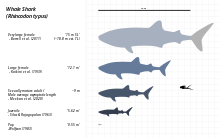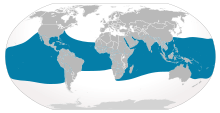| Whale shark Temporal range:
| |
|---|---|

| |
| Whale shark in the Andaman Sea around the Similan Islands | |

| |
| The size of various whale shark individuals with a human for scale | |
| Scientific classification | |
| Domain: | Eukaryota |
| Kingdom: | Animalia |
| Phylum: | Chordata |
| Class: | Chondrichthyes |
| Subclass: | Elasmobranchii |
| Order: | Orectolobiformes |
| Family: | Rhincodontidae |
| Genus: | Rhincodon A. Smith, 1829[7][6] |
| Species: | R. typus
|
| Binomial name | |
| Rhincodon typus | |

| |
| Range of whale shark[needs update] | |
| Synonyms | |
| |
The whale shark (Rhincodon typus) is a slow-moving, filter-feeding carpet shark and the largest known extant fish species. The largest confirmed individual had a length of 18.8 m (61.7 ft).[8] The whale shark holds many records for size in the animal kingdom, most notably being by far the most massive living non-cetacean animal. It is the sole member of the genus Rhincodon and the only extant member of the family Rhincodontidae, which belongs to the subclass Elasmobranchii in the class Chondrichthyes. Before 1984 it was classified as Rhiniodon into Rhinodontidae.
Whale sharks inhabit the open waters of all tropical oceans. They are rarely found in water below 21 °C (70 °F).[2] Whale sharks' lifespans are estimated to be between 80 and 130 years, based on studies of their vertebral growth bands and the growth rates of free-swimming sharks.[9][10][11] Whale sharks have very large mouths and are filter feeders, which is a feeding mode that occurs in only two other sharks, the megamouth shark and the basking shark. They feed almost exclusively on plankton and small fishes and pose no threat to humans.
The species was distinguished in April 1828 after the harpooning of a 4.6 m (15 ft) specimen in Table Bay, South Africa. Andrew Smith, a military doctor associated with British troops stationed in Cape Town, described it the following year.[12] The name "whale shark" refers to the animal's appearance and large size; it is a fish, not a mammal, and (like all sharks) is not closely related to whales.[13] In addition, its filter feeding habits are similar to baleen whales.
- ^ "Rhincodon typus in the Paleobiology Database". Fossilworks. Archived from the original on 27 May 2022. Retrieved 17 December 2021.
- ^ a b Pierce, S.J.; Norman, B. (2016). "Rhincodon typus". IUCN Red List of Threatened Species. 2016: e.T19488A2365291. doi:10.2305/IUCN.UK.2016-1.RLTS.T19488A2365291.en. Retrieved 19 November 2021.
- ^ "Appendices | CITES". cites.org. Retrieved 14 January 2022.
- ^ a b Cite error: The named reference
Smith, 1828was invoked but never defined (see the help page). - ^ Cite error: The named reference
Penrith, 1972was invoked but never defined (see the help page). - ^ a b Cite error: The named reference
Melville, 1984was invoked but never defined (see the help page). - ^ Cite error: The named reference
Smith, 1829was invoked but never defined (see the help page). - ^ McClain CR, Balk MA, Benfield MC, Branch TA, Chen C, Cosgrove J, Dove ADM, Gaskins LC, Helm RR, Hochberg FG, Lee FB, Marshall A, McMurray SE, Schanche C, Stone SN, Thaler AD. 2015. "Sizing ocean giants: patterns of intraspecific size variation in marine megafauna". PeerJ 3:e715 doi:10.7717/peerj.715.
- ^ Hsu, Hua Hsun; Joung, Shoou Jeng; Hueter, Robert E.; Liu, Kwang Ming (2014). "Age and growth of the whale shark (Rhincodon typus) in the north-western Pacific". Marine and Freshwater Research. 65 (12): 1145. doi:10.1071/MF13330. ISSN 1323-1650.
- ^ Colman, J. G. Froese, Ranier; Pauly, Daniel (eds.). "Rhincodon typus". FishBase. Retrieved 17 September 2006.
- ^ Perry, Cameron T.; Figueiredo, Joana; Vaudo, Jeremy J.; Hancock, James; Rees, Richard; Shivji, Mahmood (2018). "Comparing length-measurement methods and estimating growth parameters of free-swimming whale sharks (Rhincodon typus) near the South Ari Atoll, Maldives". Marine and Freshwater Research. 69 (10): 1487. doi:10.1071/MF17393. ISSN 1323-1650.
- ^ Martin, R. Aidan. "Rhincodon or Rhiniodon? A Whale Shark by Any Other Name". ReefQuest Centre for Shark Research.
- ^ Brunnschweiler, J. M.; Baensch, H.; Pierce, S. J.; Sims, D. W. (3 February 2009). "Deep-diving behaviour of a whale shark Rhincodon typus during long-distance movement in the western Indian Ocean". Journal of Fish Biology. 74 (3): 706–14. Bibcode:2009JFBio..74..706B. doi:10.1111/j.1095-8649.2008.02155.x. PMID 20735591.
